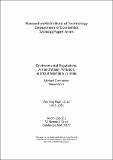Environmental Regulations, Air and Water Pollution, & Infant Mortality in India
Author(s)
Greenstone, Michael; Hanna, Rema
DownloadGreenstone1111.pdf (1.194Mb)
Terms of use
Metadata
Show full item recordAbstract
Using the most comprehensive data file ever compiled on air pollution, water pollution, environmental regulations, and infant mortality from a developing country, the paper examines the effectiveness of India’s environmental regulations. The air pollution regulations were effective at reducing ambient concentrations of particulate matter, sulfur dioxide, and nitrogen dioxide. The most successful air pollution regulation is associated with a modest and statistically insignificant decline in infant mortality. However, the water pollution regulations had no observable effect. Overall, these results contradict the conventional wisdom that environmental quality is a deterministic function of income and underscore the role of institutions and politics.
Description
February 18, 2013 revision to this paper is available at http://hdl.handle.net/1721.1/81950.
Date issued
2011-07-01Publisher
Cambridge, MA: Department of Economics, Massachusetts Institute of Technology
Series/Report no.
Working paper (Massachusetts Institute of Technology, Department of Economics);11-11
Keywords
Air pollution, Water pollution, Benefits of environmental regulations, India
Collections
The following license files are associated with this item: